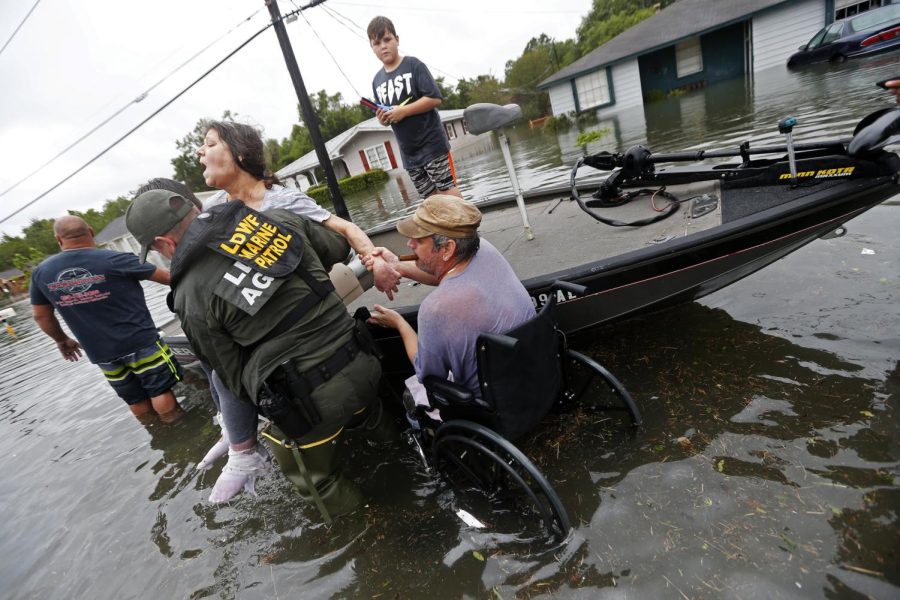Houston braces for Hurricane Harvey’s second swipe
Members of the Louisiana Department of Wildlife and Fisheries help rescue Mike Henry, right, and his partner Rosemarie Carpenter during flooding from Tropical Storm Harvey in Orange, Texas, Wednesday, Aug. 30, 2017.
August 30, 2017
The storm, meanwhile, began to give up some of its dead.
The confirmed death toll from the hurricane climbed to 21 after a woman’s body was discovered afloat in Beaumont. Also, the bodies of six family members, including four children, were pulled from a van that had been swept off a Houston bridge into a bayou, and authorities were investigating 17 more deaths to determine whether they were storm-related.
“Unfortunately, it seems that our worst thoughts are being realized,” Harris County Sheriff Ed Gonzalez said after the van was found in 10 feet of muddy water.
While conditions in Houston appeared to improve, the disaster took a turn for the worse east of the city, close to the Louisiana line.
Beaumont and Port Arthur, Texas, struggled with rising floodwaters and worked to evacuate residents after Harvey completed a U-turn and rolled ashore early Wednesday for the second time in six days, hitting southwestern Louisiana as a tropical storm with heavy rain and winds of 45 mph.
For much of the rest of the Houston area, forecasters said the rain is pretty much over and the water is already back within its channels in some places. Houston Mayor Sylvester Turner said the city’s two major airports would reopen late in the afternoon.
“We have good news,” said Jeff Lindner, a meteorologist with the Harris County Flood Control District. “The water levels are going down.”
Nevertheless, many thousands of homes in and around the nation’s fourth-largest city still were under water from the record-breaking deluge of 4 feet of rain and could stay that way for days or weeks.
Officials said 911 call centers in the Houston area were still getting more than 1,000 calls an hour from people seeking help. The Coast Guard said it was operating 21 helicopters and more than two dozen shallow-draft boats to help in the effort.
About 10,000 more National Guard troops are being deployed to Texas, bringing the total to 24,000, Gov. Greg Abbot said.
The scale of the catastrophe in Texas began to come into sharper focus: More than 1,000 homes were destroyed and close to 50,000 damaged, and over 32,000 people were in shelters across the state, emergency officials reported.
Authorities expect the death toll to rise as the waters recede and bodies are found in cars and homes.
The confirmed deaths from the storm include a man who tried to swim across a flooded road, a former football and track coach in suburban Houston and a woman who died after she and her young daughter were swept into a drainage canal in Beaumont. The child was rescued clinging to her dead mother, authorities said.
About 195,000 people have filed for financial assistance, and about $35 million in direct aid has been distributed — numbers expected to climb dramatically in the coming days and weeks, the chief of the Federal Emergency Management Agency said.
“This is going to be an incredibly large disaster,” Brock Long said in Washington. “We’re not going to know the true cost for years to come. … But it’s going to be huge.”
Harvey itself was “spinning down” and expected to weaken sometime Wednesday into a tropical depression, meaning winds of 38 mph or less, National Hurricane Center meteorologist Dennis Feltgen said.
Forecasters said the remnants of the hurricane will move from Louisiana into Mississippi, Tennessee and Kentucky in the next few days, with flooding possible in those states.
“Once we get this thing inland during the day, it’s the end of the beginning,” Feltgen said. “Texas is going to get a chance to finally dry out as this system pulls out.”
Eugene Rideaux, a 42-year-old mechanic who showed up at evangelist Joel Osteen’s Houston megachurch to sort donations for evacuees, welcomed the reprieve from the rain.
He said he had not been able to work or do much since the storm hit, so he was eager to get out of his dark house and help.
“It’s been so dark for days now, I’m just ready to see some light. Some sunshine. I’m tired of the darkness,” Rideaux said. “But it’s a tough city, and we’re going to make this into a positive and come together.”
When Harvey paid its return visit to land overnight, it hit near Cameron, Louisiana, about 45 miles from Port Arthur.
Port Arthur found itself increasingly isolated as floodwaters swamped most major roads out of the city and spilled into a storm shelter with about 100 people inside. Motiva Enterprises closed its Port Arthur refinery, the largest in the nation, because of flooding.
Port Arthur Mayor Derrick Freeman posted on his Facebook page: “Our whole city is underwater right now, but we are coming!” He urged residents to move to higher ground and avoid getting trapped in attics.
Harvey initially came ashore as a Category 4 hurricane in Texas on Friday, then went back out to sea and lingered off the coast as a tropical storm for days, inundating flood-prone Houston.
Harvey’s five straight days of rain totaled close to 52 inches, the heaviest tropical downpour ever recorded in the continental U.S.
Associated Press writers Frank Bajak and Michael Graczyk in Houston, Diana Heidgerd and David Warren in Dallas, Seth Borenstein in Washington and Tammy Webber in Chicago contributed to this report.












